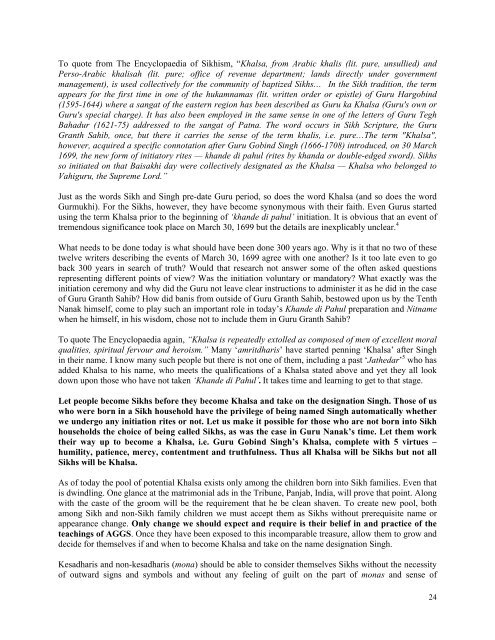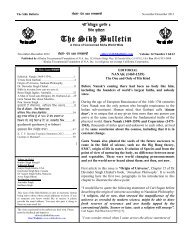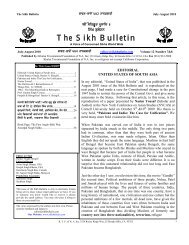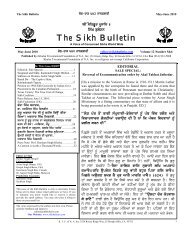Selected Editorials - The Sikh Bulletin
Selected Editorials - The Sikh Bulletin
Selected Editorials - The Sikh Bulletin
You also want an ePaper? Increase the reach of your titles
YUMPU automatically turns print PDFs into web optimized ePapers that Google loves.
To quote from <strong>The</strong> Encyclopaedia of <strong>Sikh</strong>ism, “Khalsa, from Arabic khalis (lit. pure, unsullied) and<br />
Perso-Arabic khalisah (lit. pure; office of revenue department; lands directly under government<br />
management), is used collectively for the community of baptized <strong>Sikh</strong>s… In the <strong>Sikh</strong> tradition, the term<br />
appears for the first time in one of the hukamnamas (lit. written order or epistle) of Guru Hargobind<br />
(1595-1644) where a sangat of the eastern region has been described as Guru ka Khalsa (Guru's own or<br />
Guru's special charge). It has also been employed in the same sense in one of the letters of Guru Tegh<br />
Bahadur (1621-75) addressed to the sangat of Patna. <strong>The</strong> word occurs in <strong>Sikh</strong> Scripture, the Guru<br />
Granth Sahib, once, but there it carries the sense of the term khalis, i.e. pure…<strong>The</strong> term "Khalsa",<br />
however, acquired a specific connotation after Guru Gobind Singh (1666-1708) introduced, on 30 March<br />
1699, the new form of initiatory rites — khande di pahul (rites by khanda or double-edged sword). <strong>Sikh</strong>s<br />
so initiated on that Baisakhi day were collectively designated as the Khalsa — Khalsa who belonged to<br />
Vahiguru, the Supreme Lord.”<br />
Just as the words <strong>Sikh</strong> and Singh pre-date Guru period, so does the word Khalsa (and so does the word<br />
Gurmukhi). For the <strong>Sikh</strong>s, however, they have become synonymous with their faith. Even Gurus started<br />
using the term Khalsa prior to the beginning of ‘khande di pahul’ initiation. It is obvious that an event of<br />
tremendous significance took place on March 30, 1699 but the details are inexplicably unclear. 4<br />
What needs to be done today is what should have been done 300 years ago. Why is it that no two of these<br />
twelve writers describing the events of March 30, 1699 agree with one another Is it too late even to go<br />
back 300 years in search of truth Would that research not answer some of the often asked questions<br />
representing different points of view Was the initiation voluntary or mandatory What exactly was the<br />
initiation ceremony and why did the Guru not leave clear instructions to administer it as he did in the case<br />
of Guru Granth Sahib How did banis from outside of Guru Granth Sahib, bestowed upon us by the Tenth<br />
Nanak himself, come to play such an important role in today’s Khande di Pahul preparation and Nitname<br />
when he himself, in his wisdom, chose not to include them in Guru Granth Sahib<br />
To quote <strong>The</strong> Encyclopaedia again, “Khalsa is repeatedly extolled as composed of men of excellent moral<br />
qualities, spiritual fervour and heroism.” Many ‘amritdharis’ have started penning ‘Khalsa’ after Singh<br />
in their name. I know many such people but there is not one of them, including a past ‘Jathedar’ 5 who has<br />
added Khalsa to his name, who meets the qualifications of a Khalsa stated above and yet they all look<br />
down upon those who have not taken ‘Khande di Pahul’. It takes time and learning to get to that stage.<br />
Let people become <strong>Sikh</strong>s before they become Khalsa and take on the designation Singh. Those of us<br />
who were born in a <strong>Sikh</strong> household have the privilege of being named Singh automatically whether<br />
we undergo any initiation rites or not. Let us make it possible for those who are not born into <strong>Sikh</strong><br />
households the choice of being called <strong>Sikh</strong>s, as was the case in Guru Nanak’s time. Let them work<br />
their way up to become a Khalsa, i.e. Guru Gobind Singh’s Khalsa, complete with 5 virtues –<br />
humility, patience, mercy, contentment and truthfulness. Thus all Khalsa will be <strong>Sikh</strong>s but not all<br />
<strong>Sikh</strong>s will be Khalsa.<br />
As of today the pool of potential Khalsa exists only among the children born into <strong>Sikh</strong> families. Even that<br />
is dwindling. One glance at the matrimonial ads in the Tribune, Panjab, India, will prove that point. Along<br />
with the caste of the groom will be the requirement that he be clean shaven. To create new pool, both<br />
among <strong>Sikh</strong> and non-<strong>Sikh</strong> family children we must accept them as <strong>Sikh</strong>s without prerequisite name or<br />
appearance change. Only change we should expect and require is their belief in and practice of the<br />
teachings of AGGS. Once they have been exposed to this incomparable treasure, allow them to grow and<br />
decide for themselves if and when to become Khalsa and take on the name designation Singh.<br />
Kesadharis and non-kesadharis (mona) should be able to consider themselves <strong>Sikh</strong>s without the necessity<br />
of outward signs and symbols and without any feeling of guilt on the part of monas and sense of<br />
24
















